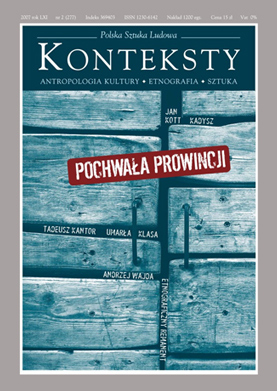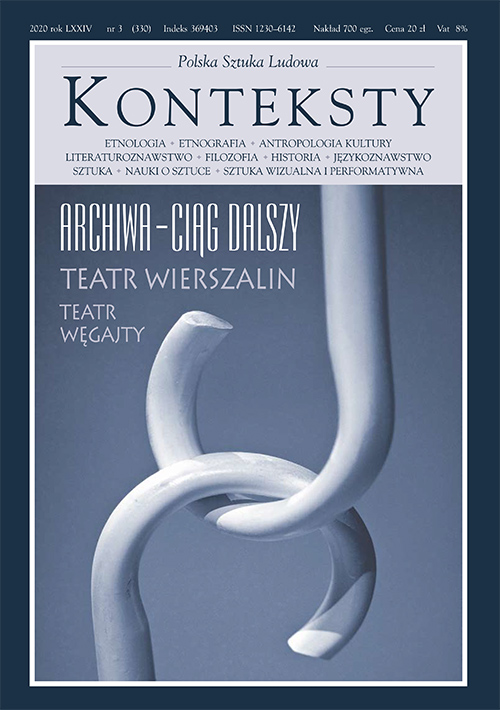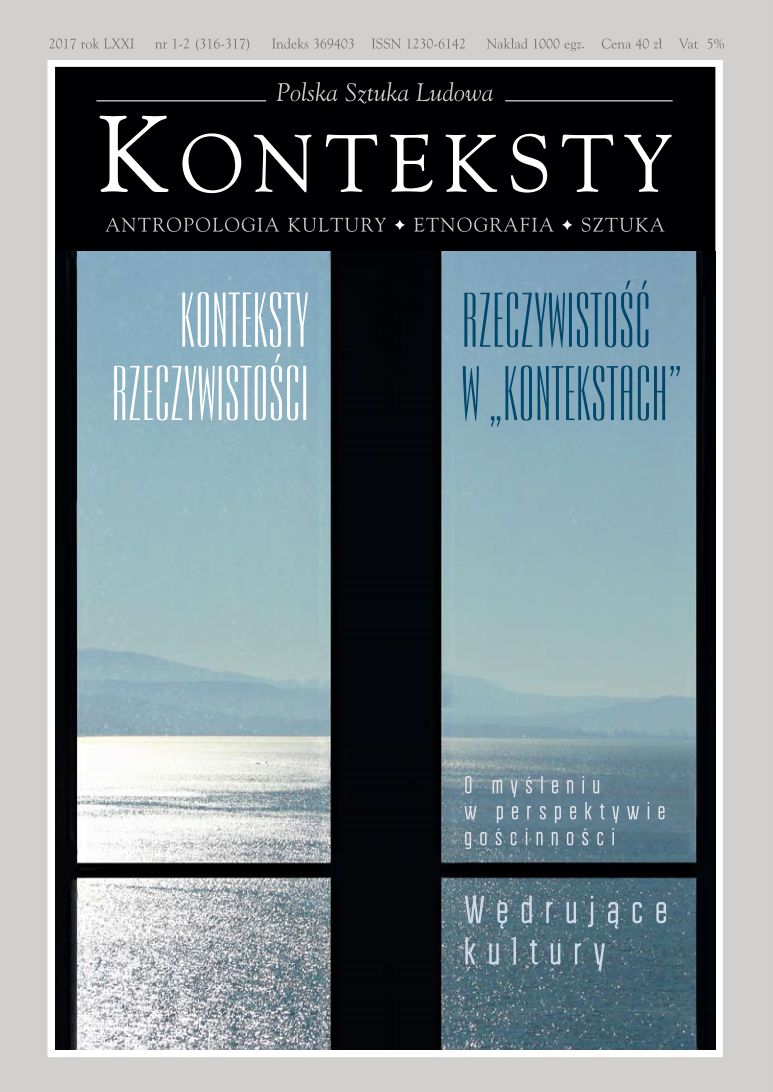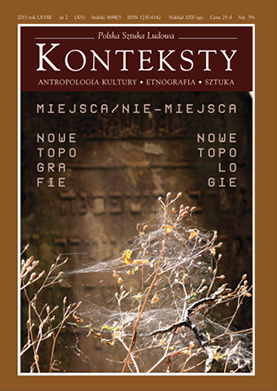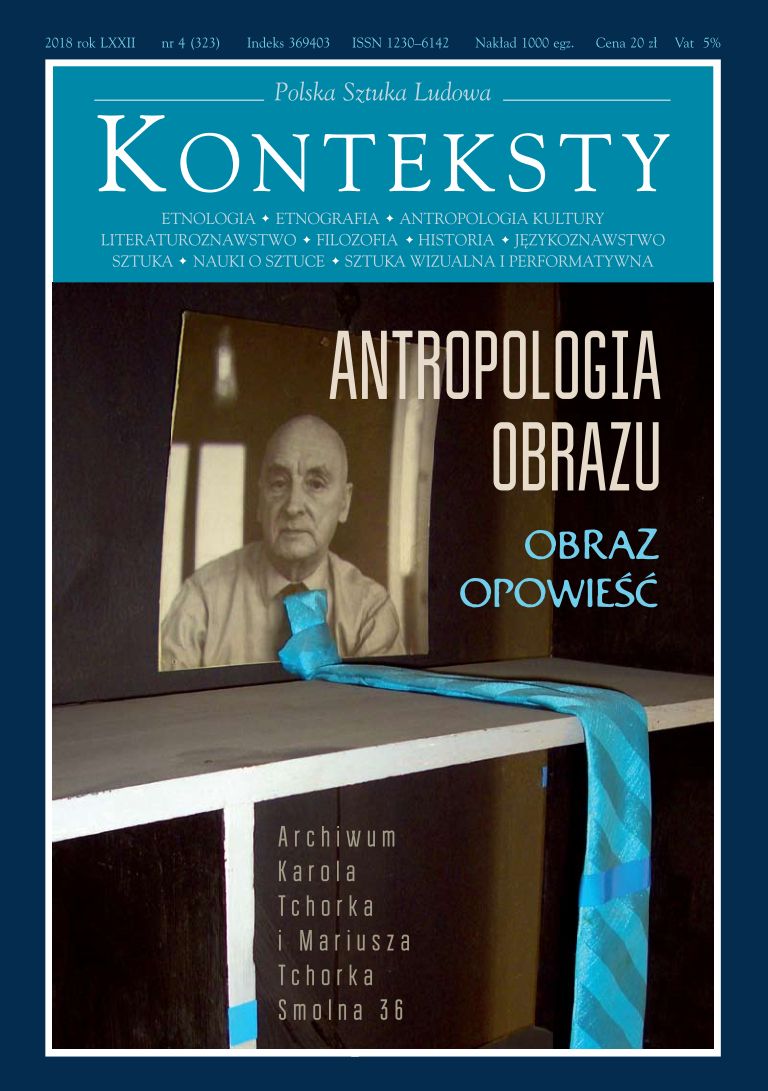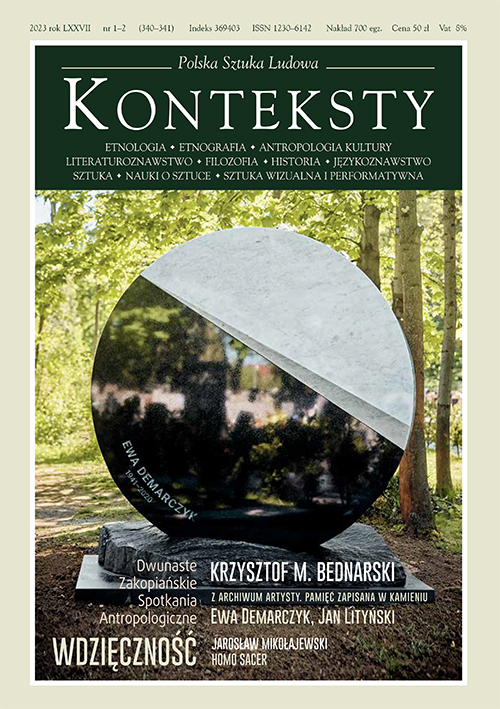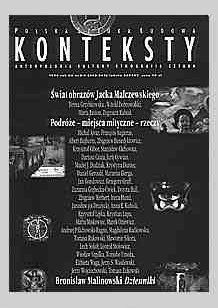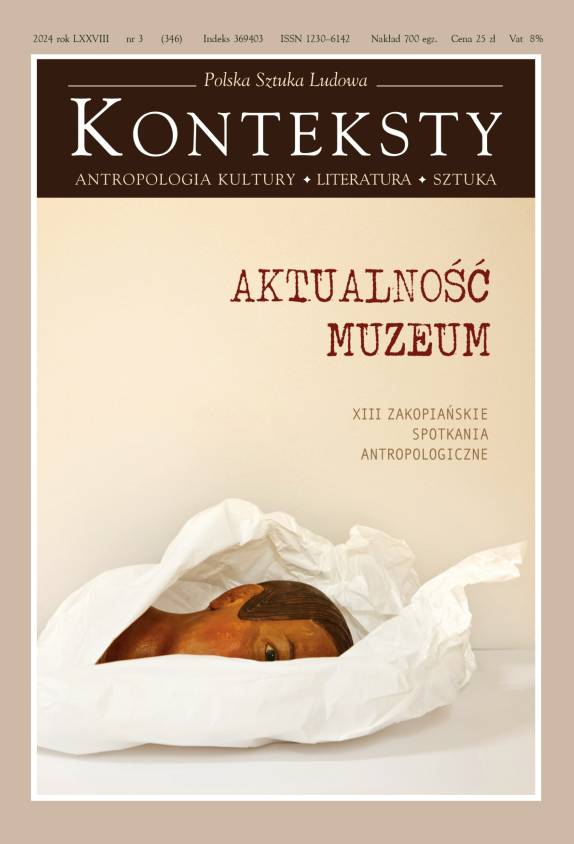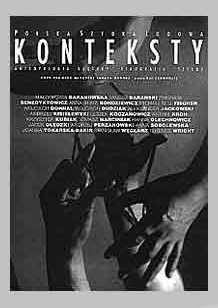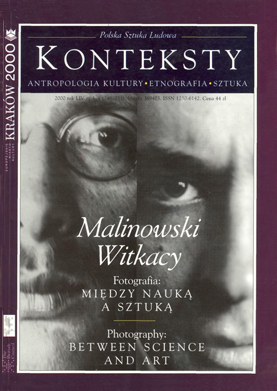Issue 2001/1-4 (252-255) - Konteksty

| Zbigniew Benedyktowicz | ||
| Zbigniew Benedyktowicz | To Render the Mystery Closer. An Interview with Włodzimierz Staniewski  | |
Asked about his plans the artist develops the motif of further stages of a trip to Greece and the sources of the drama. He analyses the figure of Euripides, which will comprise the focal point of a consecutive theatrical project. In response to a question concerning the significance of his cooperation with Jerzy Grotowski, dramatic departure and the foundation of his own theatre, he outlines the differences between the Grotowski theatre and “Gardzienice”, and describes his last meetings with J. Grotowski. | ||
| Włodzimierz Staniewski | ||
| Włodzimierz Staniewski | ||
| Mariusz Gołaj | "Metamorphoses" - an Actors Notes  | |
Collected reflections by one of the "Gardzienice" actors referring to work on The Golden Ass. | ||
| Tomasz Rodowicz | "Onou Orchesis" - the Dance of the Ass. About Work on "Metamorphoses"  | |
The author - one of the co-creators and leading actors of the "Gardzienice" group - tells about behind-the-scenes aspects and the history of a spectacle. The titular spectacle, which undergoes an evolution, is the very essence of a multi-motif project, the extract of years of arduous work, wanderings down assorted cul-de-sacs, and the discovery in oneself and others certain places that would have never been revealed without this adventure. Frequently, completed and well-devised episodes were rejected because they did not contain the element of "life". The process of creation was always dominated by openness towards the unbridled imagination and creativity of each of the actors-authors, combined with complete trust towards the ultimate decisions of the director. | ||
| Krystyna Bartol | Poet`s Paideia  | |
The range of use of the multi-semantic Greek term paideia has been limited here to the exclusively educational meaning, and here it means simply: "education" "upbringing" or "forming". The expression "Poets' paideia" included in the title of the paper reflects the dichotomy, so characteristic of the residents of the ancient Hellas, the discrepancy of their views on issues connected with the process of artistic creation, being discernible in attempts to explain the very nature of the poet's profession and its being special in comparison with other aspects of human activity, and in definition of the artists' mission towards the reader that relates to the former's creation. The correlation of this diversity is the twofold path along which the poetic paideia is produced, in which the artist/creator is on the one hand a recipient of education, being on the other the author of the upbringing process. Thus, in the first part of the paper the issues discussed will be the main aspects related to the rationally inexplicable - in the Greeks' opinion - moment when one actually becomes a poet, and also presented will be the epic and lyrical incarnation of the topos - the so-called Dichterweihe, along with the richness of its initiatory and mystic references. The second part of the dissertation will consider matters connected with the poetic docere (teaching). These are understood as the stimulation of the auditor, assisted by a divine authority, aiming at getting him acquainted progressively deeper with those secrets of the art of life that would not be available to him without the intermediation of those who had been chosen by the Muses and Apollo. | ||
| Jerzy Danielewicz | Table Initiations - Reflections on the Greek Symposion  | |
The feast (repast), and in particular that part which followed the main course (symposion), occupies a special place in the culture of the ancient Greece. During the archaic and classical epochs, which are best known to us today, a series of features can be observed, which allow us to juxtapose and compare the symposion with religious rituals and analyse it as an esoteric institution, a selected society within which special norms and customs applied (what is particularly notable being the important role of homosexual relations between men). In the course of initiation, features and qualities respected in the Greek polis were formed, attributes particularly cultivated by the aristocracy, since the symposion derives many of its qualities from the period when the nobility held a dominant position in the army, where the event functioned as an aristocratic military "club". In the colourful "sympotic space" there was a place not only for entertainment, but also for paideia; an important instrument for the latter being poetry, for the performance of which a symposion created both a background and an opportunity. | ||
| Włodzimierz Lengauer | Dionysis Kourotrophos? Initiations of Male Youth in Ancient Greece and the Cult of Dionysis  | |
The characteristic feature of the Greek Dionysis (one of many, to speak candidly) is his appearance in female disguise and in a female form. Due to his character, the god is described as dimorphos. This is not merely a matter of fantasy among poets or mythographs but is an element of the rich Dionysian mythology. The Dionysian rituals show such behavioral examples of his worshippers, in which the traditional distinction between the sexual roles of male and female is not observed. On the other hand, it is well known that a blurring of the border between sexes and a ritual transvestitism occur in many initiation rituals (which is best proven by some marital rituals) connected with youth, or rather with reaching full social maturity. Of Dionysian rituals, such character is most discernible in the feast in Patrai as described by Pausanias (VII19.1-20.2)- It was assigned the category of a youth initiation ritual by Gerhard Baudy. Even before this, attention was drawn to the possibility of associating the genesis of tragic choirs with the initiation of youth (John Winkler). This view is rather slenderly based and it was not accepted by the world of science, but the relationship of Dionysus to the initiation of youth seems, nonetheless, very close. The point is that Dionysus neither looks after the upbringing processes, nor has any noticeable relation with sexual maturity among boys (as does Artemis in respect of girls), so it is not dear why this god should be related to the social maturity of youth. Such a relationship seems obvious with Hermes and Herades (physical fitness, labour and combat), possible and probable with Apollo (upbringing, education, the character of Apollo as the original deity of the fratria), however, the relation of Dionysus with maturity of young people may evoke reactions of surprise. It seems that the answer to the question about the nature of and reasons for this relationship should be sought first of all in the very character of Dionysus as an ambivalent, ambiguous and very often deceitful deity of the transition stages, a deity who himself disturbs and restores the worldly order. Dionysus embodies and shows to his worshippers the hazards of the savage world, and, at the same time he shows the ways to control and use them. Therefore he is also the god of social maturity, which should be developed by young people, realizing its disadvantages and the danger of the stale in which its basis can become weakened. Thus, Dionysian rituals may also symbolize the path young people follow approaching maturity, and how through the ritual distortion of normality they may affirm its relevance. Also in this way Dyonisis may be considered a deity of kourotrophos type. | ||
| Lech Trzcionkowski | The Demeter Mysteries in Attica The Lykomidai Rituals in Phyla - between Initiation and Mystery  | |
Ancient authors frequently mentioned the mysteries which took place in the clan sanctuary of the Lykomidai in the Attic deme of Phyla. The mysteries were held in two temples located in a single holy circle: the first with altars of Apollo Dionysodotes, Artemis Selasphoros, Dionysus Anthios, Nimphai Ismenidai and Ge (Megale theos); the second temple contained altars of Demeter Anasidora, Zeus Ktesios, Athena Tithrone, Kore Protogone and Semnai Theai. The presence of numerous deities is connected by the idea of the initiation of young people via wine and dance. The whole ceremony was steered by Demeter and Zeus as the guardians of the welfare of the community. Owing to their archaic character the Phyla mysteries seem to be inscribed into a more general scheme linking an introduction into the mystery of life and death with the initiation rituals. Just as engrossing is the history of the Lykomidai clan and sanctuary. The hall of initiation (telesterion) was the common property of genos Lykomidai. Burnt down by the armies of Xerxes (480 B, C.) it was rebuilt and decorated with murals by Themistocles, a member of the clan (478-472). Writings of the gnostic Sethian sect recall that during the Roman era the walls of the portico featured a mural depicting Phaos chasing Phykola (gnostic interpretation or impact). During the fourth century B.C. Methapos, who came from Phyla, “revived” the celebrated mysteries in Andania by introducing the myth of the Messenian origin of the rituals performed in Athens. The Lykomidai chanted Orphic songs during the rituals, including hymns to Eros ascribed to Pamphos and Orpheus as well as a hymn to Demeter, written by Mousaioa. As a boy, Euripides served in the sanctuary as a cupbearer, pouring wine for the dancers. The possible impact of the theology of the Phyla mysteries upon his hymn to the Mother in the tragedy Helena remains within the sphere of suppositions. | ||
| Giovanni Cerri | Ancient Greek Poems on Nature and Mysteries Rituals  | |
Careful reading of some fragments by Empedokles and of the “Introduction” by Parmenides proves beyond doubt that their poems about nature were, to a certain extent, related to local rituals; that is, respectively: with the famous Demetrian mysteries in Akragas (and, perhaps, also in Thurioi) and in Eleia. Speaking more precisely - the doctrines of these philosophers on the elements and existence should be presented simultaneously both as an interpretation of divine systems and of mythical tales specifically characteristic of these sanctuaries and rituals. In this manner one can envisage, as far as archaic Greek culture is concerned (or at least at some of its sites, particularly in Sicily and in Greater Greece), a picture of a perfect harmony between scientific research and religious beliefs - a harmony reached through the technique of theological reinterpretation. Assumptions found in some fragments of Xenophanes' works seem to be aimed in a similar direction. | ||
| Warren D. Anderson | The Ethical and Spiritual Aspects of Ancient Greek Music  | |
The author discusses only two, briefly outlined aspects of ancient Greek music, namely, its spiritual and ethical dimensions. Scarce preserved fragments entitle us to surmise that one of the social functions of traditional Greek songs was the transmission of moral directives and teachings (cf. suitable fragments of the Iliad and the Odyssey). The author also ponders whether and to what extent it would be sensible to speak about spirituality in Old Greek music considering that the modern division into material and spiritual values has little in common with Greek mentality, and blurs the perception of its specificity. | ||
| Leszek Kolankiewicz | Polish Spectacles and the Religion of Dionysus  | |
The problems broached in the text are situated along the borderline between religious studies and theatrology. Their point of departure consists of two issues: the problematic nature of ancient Polish deities and the ideological and staging aspects of Dziady (Forefathers' Eve), the arch-drama by A. Mickiewicz. By resorting to the classical tripartite division of Indo-European mythology devised by Dumezil, the author reconstructed, upon the basis of a meticulous analysis of Old Polish literature, the pantheon of Slavic deities, indicating the incompatibility of the tripartite division in relation to Polish mythology. Emphasis is placed on the distinctive presence in Slavonic beliefs of deities protecting the spirits "in the other world". The author paid special attention to connections between Polish annual rites associated with the winter-spring cycle (the marked role played by women) and the Athenian festivities in honour of Dionysus. L. Kolankiewicz claims that A. Mickiewicz conducted numerous parallels both with the Greek Anthesteria and rites known from descriptions of ethnographic exotica; "he suddenly discerned Greek and Afro-American rites in his own county". The writing of Dziady is comprehended as a myth-creating process. The hero of the drama, "the Hero of the Poles'', is a mythical hero, combining the ideas of rebirth, salvation and redemption. | ||
| Krzysztof Rutkowski | Poetry and Rite. The world and Tradition according to Mickiewicz  | |
Talking of transfer of tradition takes us back to the Bible, and in particular to Genesis and the myth of Adam and Eve about the creation of the body, the soul and the language. The mystic Jewish tradition, but not only Jewish, paid special attention at the bodily genesis of cognition, seeking the reflection of all intellectual activity in bodily activities. Even the most abstract theological categories have their roots in the somatic structure of the human being. Transfer of tradition "from hand to hand" - as Mickiewicz said at the Collège de France - in other words contact of the living with the dead, or the Dziady (a distant Lithuanian equivalent of Halloween - translator's note) celebration - would be based on a careful, modest reinterpretation of the promise included in the first Book of the Old Testament and reading of the story about God's bodily sacrifice, confirmed by the Evangelists. | ||
| Zbigniew Taranienko | The Golden Ass of "Gardzienice" - the Uncovering of the Face of Greece  | |
A reflection by an expert on the theatre and culture concerning The Golden Ass - the most recent spectacle staged by "Gardzienice". The point of departure of the spectacle, its pre-matter is music - discovered and reconstructed musical fragments from the fifth century B. C. to the third century A. D. In this case, the Metamorphoses by Apuleius was only an inspiration, a pretext for a new construction, and the spectacle is by no means a theatrical replica of the classical text. The author maintains that in The Golden Ass Staniewski created his own myth, produced in a creative dialogue with Greek tradition. The "uncovering of the face of Greece" is simultaneously the unveiling of oneself. The Golden Ass is certainly not a contemporary version of a mystery, but rather a dialogic paideia. Staniewski did not propose a mystery initiation, but disclosed living tradition and showed the paths leading towards it. | ||
| Dariusz Kosiński | From, in-between and Towards. "Mysteries and Initiations" Festival, Krakow 2000  | |
One of the more significant topics discussed during the Mysteries and Initiations Festival was the borderline between the theatre and the spectacle, on the one hand, and religion and the rite, on the other hand. Key importance is ascribed to the mystery comprehended (following the example of Włodzimierz Staniewski) as a phenomenon possessing two aspects: esoteric (religious) - intended for the initiated, and exoteric (spectacular), addressed to the viewers. The reference of this definition to two events which took place in the course of the Festival - the Santeri ritual and the Whirling Dervish ceremony - demonstrates the diverse determinants and ambiguities associated with the presence of the traditional mystery within an alien cultural context. On the other hand, Metamorphoses, featured by the "Gardzienice" Centre of Theatrical Practices, proves to be a successful attempt at creating a "new mystery" - a spectacle built by theatrical means which revitalise those values that comprise the core of West European culture. | ||
| Lech Trzcionkowski, Zbigniew Taranienko, Włodzimierz Staniewski, Richard Schechner, Czesław Robotycki, Włodzimierz Lengauer, Tomasz Kubikowski, Wiesław Juszczak, Ireneusz Guszpit, Jacek Dobrowolski, Jerzy Danielewicz, Krystyna Bartol | Festival. "Mysteries and Initiations"  | |
A panel discussion with the participation of Krystyna Bartol , Jerzy Danielewicz , Jacek Dobrowolski, Ireneusz Guszpit, Wieslaw Juszczak, Tomasz Kubikowski, Włodzimierz Lengauer, Czesław Robotycki, Richard Schechner, Włodzimierz Staniewski, Zbigniew Taranienko and Lech Trzcionkowski. A discussion conducted by specialists in ancient Greece, mysteries, religion, and the anthropology of the theatre. The topics include the Eleusian mysteries (L. Trzcionkowski), and the engrossing interpretation motif in Bacchantes, the most Dionysian tragedy by Euripides from the viewpoint of wisdom, sophia; being wise is associated with the retention of moderation, sophronein ( W. Lengauer ). An important motif is the distinction between the theatre and the ritual, the possibility of the "unbelievers" or the "uninitiated" taking part in a culturally alien rite, with emphasis placed on the ethics of viewing a rite unintended for "outsiders". The discussion frequently refers to the Afro-Cuban Santeria ritual, seen on the previous day and performed by a specially invited Cuban ensemble. | ||
| Michael Lambert | Ethics in Classical Athens and Traditional African Ethics: the Hermeneutic of Shame and Guilt  | |
A text read at the international Mysteries and Initiations Festival (Cracow 2000). The author embarked upon an attempt at contrasting two ethical systems of the ancient Athenians and contemporary Africans by asking whether upon the threshold of a new millennium we are capable of learning something from a comparison pertaining to individualism and communitarianism, which could prove helpful for shaping a new ethic of tolerance and sensitivity. A discussion of the way in which such essential moral feelings as shame and guilt function in those societies in which the community is more important than the individual, and in those where the situation is the opposite. | ||
| Jadwiga M. Rodowicz | The Song as a Nucleus of the Actors Work on Stage  | |
The article aims at the comparison between the techniques used in the traditional Japanese No theatre and in contemporary work conducted by Staniewski with his actors in the "Gardzienice" Centre for Theatrical Practice, centered around building the theatre language (the actor's expression) on the basis of the song. The fundamental component is the "song-like phrase" (Polish: zaśpiew), regarded as equal to the ku element in No. The bigger unit is a whole song (poem), which serves building the dialogue between actors on stage, while the exchange of songs leads, in both forms, to constructing a chain of pictures (metaphors) giving rise to dramatic tension. Thus, very much in a way similar to No drama, the dramatic text aims not so much at the reconstruction of events, but rather at compressing images and metaphors into a sequence that ultimately culminates at the "breakthrough" of the final scene. In terms of performance technique, the used method seems to follow the rule of jo-ha-kujo-ha-ku (introduction-development-rapid climax), as devised by Zeami. Strong prevalence of music over semantics can be observed in the formation of the two theatrical forms, and it is music, intricate in theatre material, and not the literary text that gives the basic meaning to what the audience perceives. Music precedes and articulates all theatre language. This factor once again influences actor's work on himself (the role), since he has to concentrate simultaneously on rhythm, building the metaphor, and dialogue with objects (partners and objects in his memory/imagination). The outcome changes the whole paradigm of the presence of dramatis personae (scattered throughout the material). | ||
| * | Trust and a Return to the Beginning. Piotr Machul talks with Maciej Rychły about Work on Music to Carmina Burana and Metamorphoses  | |
For past several years Maciej Rychły has been responsible for the music in the spectacles staged by "Gardzienice" theatre, i.e. Carmina Burana and Metamorphoses. In the interview, M. Rychły presents the assorted motifs of his collaboration with the Włodzimierz Staniewski group, drawing attention to the fact that the point of departure was music played jointly after a spectacle, i.e. the Gathering - one of the basic artistic practices of the "Gardzienice" theatre. From the very beginning, the “Gardzienice” Group was interested in various types of music - folk, Russian Orthodox liturgy, mediaeval and classical Greek. M. Rychły underlines the fact that "Gardzienice" is primarily a musical theatre, a feature unnoticed by many critics. He pays particular attention to the music used in Metamorphoses, and refers to work with Howard Brenton and the Royal Shakespeare Company, as well as the Excursion to Egypt, work with the actors during rehearsals, and attempts at reconstructing music recorded on stone and papyri. Finally, M. Rychły recalls the relation between the music of ancient Greece and Arabia, the theory of rhythm, and the so-called human second. Work on every "Gardzienice" spectacle changes not only the musical material, but also the actors' training and dramaturgy. This neither a revolution nor an evolution. "This is trust and a return to the beginning" - M. Rychły declares. | ||
| Jan Stęszewski | Music of Greek Antiquity, "Gardzienice" and Maciej Rychły  | |
The "phonosphere" (the sound and musical aspects) of the spectacle Metamorphoses, staged by the theatre in Gardzienice, is the work of Maciej Rychły. Its extraordinariness consists of the fact that this is by no means a simple attempt at recreating ancient Greek music upon the basis of extant sources, but a combination of old Greek material, musical archaisms and Oriental themes (mainly Balkan}, preserved in oral tradition and invented by the composer. The phonosphere of Metamorphoses can and should be considered within the context of antecedents (such as historicism, Orientalism and folklorism) and as an artistic proposal.
A Dance with Tradition as if with the François Vase. A Conversation about "Gardzienice" and Metamorphoses with the participation of Krystyna Bartol , Anna Wyka, Zbigniew Benedyktowicz , Jerzy Danielewicz , Jacek Dobrowolski , Ireneusz Guszpit, Dariusz Kosiński, Tomasz Kubikowski, Włodzimierz Langauer, Czesław Robotycki, Tomasz Rodowicz , Maciej Rychły, Włodzimierz Staniewski, Zbigniew Taranienko , Lech Trzcionkowski , Magdalena Bartnik, Agata Zyglewska and Paweł Passini. An account of the conversation held at the beginning of this year in Gardzienice. The participants continued certain motifs from a panel discussion in Cracow, but primarily focused on three issues: 1. My experiences of cooperation with „ Gardzienice"; 2. Opinions and declarations about Metamorphoses; 3. The significance and role of initiation and mysteries in contemporary culture. The speakers emphasised the relation between tradition and contemporaneity, folk and ancient culture, the anthropology of culture, hermeneutics and the theatre. | ||
| Jakob Ullman | ||
| Zofia Kałkus | ||
| Krystyna Bartol, Anna Wyka, Zbigniew Benedyktowicz, Jerzy Danielewicz, Jacek Dobrowolski, Ireneusz Guszpit, Dariusz Kosiński, Tomasz Kubikowski, Włodzimierz Lengauer, Czesław Robotycki, Tomasz Rodowicz, Maciej Rychły, Włodzimierz Staniewski, Zbigniew Taranienko, Lech Trzcionkowski, Magdalena Bartnik, Agata Zyglewska, Paweł Passini | ||
| Agata Zyglewska | ||
| Włodzimierz Lengauer | ||
| Howard Brenton | Give the Donkey Roses  | |
The comments and impressions of the literary director of the Royal Shakespeare Company concerning his several-year long cooperation with Włodzimierz Staniewski and the "Gardzienice" Theatrical Society in connection with a spectacle based on The Golden Ass by Apuleius. Unfortunately, due to financial reasons the jointly prepared staging was never realised. The original article appeared in Hot Irons. Diaries, Essays, Journalism, London 1998. | ||
| Zbigniew Taranienko | Twenty Years of "Gardzienice"  | |
A summary of the main motifs of a book concerning the "Gardzienice" Centre of Theatrical Practice. The author reconstructed in detail the activity of the Centre from its first theatrical undertakings to most recent spectacles. He recalled the beginnings of the "Gardzienice" ventures (Excursions, Gatherings, Training and Workshops) and presented briefly the origin and elementary meaning of successive spectacles (The Evening Spectacle, Sorcery, The Life of Avvakum the Priest, and Carmina Burana). Z. Taranienko tried to justify the thesis that despite numerous opinions the "Gardzienice" phenomenon is primarily theatrical, A special part is played by two elements: the new, "organic" conception of acting and the distinctive presence of music and songs. A further characteristic feature of "Gardzienice" is the ecological dimension of its activity: "The ensemble cultivates the ecology of the body and the spirit, focused on theatrical practice via creativity, realised in the presence of the Earth and the Sky, all the phenomena of Nature, animals and plants. It evokes the spectacles, teaches how to notice oneself, the others and all that which surrounds us - the Theatre and, simultaneously, the world." | ||
| Alison Hodge | Włodzimierz. Staniewski: "Gardzienice" and the Naturalised Actor  | |
The original article appeared in Twentieth Century Actor Training (ed. by Alison Hodge, Routledge 2000). The author considers the specificity of work with an actor in the "Gardzienice" Centre of Theatrical Practices, where he is subjected to a specific training, a “naturalisation” linked with contact with the natural environment and native culture, based on the principle of musicality and mutuality. | ||
| Lucjan Świetlicki | From the History of Gardzienice  | |
A lecture given for students of the Academy of Theatrical Practices in Gardzienice by a teacher - historian from Piaski. The main theme of the lecture is local history, important events and celebrities who had lived in or passed through Gardzienice as well as the wartime history of the local Jews. | ||
| Carol Martin | Another Kind of Metamorphosis  | |
A very personal and emotional attempt at deciphering the "Gardzienice" version of Metamorphoses, which the author perceives primarily as a play about the restoration of memory. To remember means to lament. Mourning is a way of reviving the existence of someone or something which died and is lost. Metamorphoses bring back to life the vital experiences of the ancient Greek theatre. The author deliberates on the aptness of the thesis proposed by Włodzimierz Staniewski, who maintains that the spirituality of Eastern Europe is closer to the archaic Greek traditions than the Western world. She tries to understand why the prewar Jewish world, at first glance so close to the Poles, has not, so far, become a living part of our memory; and why we had not embarked upon the task of collective mourning. | ||
| Jacek Dobrowolski | Metamorphoses and Misunderstandings  | |
A reply to Carol Martin's critique of ignoring the influence of Jewish culture by Gardzienice in their latest performance Metamorphoses and basing it on Greek culture instead. The critique is a misunderstanding as Greek drama inspired Polish theatre much more than Jewish prototheatrical Chassidic influence, or Purim festivals. Also Chassidic music and dances did not influence Polish folk music and dances. Quite on the contrary it was Polish folk music (krakowiak and mazurek dances) that influenced Jewish musicians. The only musical Jewish influence in popular music was that of klezmer city folk music in the 19th and 20th c. | ||
| Arkadiusz Cholewa | Gardzienice Stories  | |
Collected material concerning assorted Gardzienice stories, including statements made by local residents about the history of Gardzienice village. | ||
| Włodzimierz Staniewski | ||
| Jacek Dziekan | Esoteric Privacy. On Ways of Building "Personae Dramatis" in "Carmina Burana" at the "Gardzienice" Centre of Theatrical Practices  | |
In his reflections on the phenomenon of acting in Carmina Burana the author compares ways in which the actor is guided by Jerzy Grotowski and Włodzimierz Staniewski. The former accentuated the process of bringing forth a different "I" of the actor, while the latter tries to confront the actor's privacy with the reality of art. | ||
| Włodzimierz Staniewski | Directors Notes: "The Life of Avvakum the Priest", "Carmina Burana", "Metamorphoses"  | |
The director's remarks and commentaries about the above listed spectacles. | ||
| * | Around "The Life of Avvakum the Priest". Monika Kubat talks to Jerzy Nowosielski  | |
The interview with Professor Jerzy Nowosielski is composed of a thematic collection of questions, all of which focus on the icon, but aim towards the theatre. The icon is a living image, brimming with light and suffused with mysticism and the spirit, but also with pathos (suffering) and human drama. It contains the frenzied gestures of the prophets and decipherable traces of man. Professor Nowosielski envisages creativity as something quire unexceptional, a way of living, and the ever subconscious realisation of classical tradition. | ||
| Monika Kubat | Sacral Space and Theatrical Space  | |
The presented symbolic of liturgical space serves the discovery, within the experiences and forms of the theatre, of the sacrum characteristic for each of the arts. The theatrical space of The Life of Avvakum the Priest is a devised liturgical space. The space of the theatre - the site of the spectacle - intermingles with the space of liturgy on assorted levels, and transmits tension between that which is secular and that which is sacral. In its rhythm, variability and multi-level nature of events Russian Orthodox liturgy is very close to the theatrical spectacle. | ||
| Mira Żelechower-Aleksiun | Cosmos - Gardzienice  | |
My - Our Gardzienice, an exhibition displayed in the Miejska Gallery in Wrocław in 1995, launched the stage design space entitled Cosmos, realised in Berlin at the Theater der Welt in the church of St. Matthew (1999). Inspired by Włodzimierz Staniewski, the interior of the basilica was arranged in such a way as to feature the Gardzienice mist-enshrouded meadows, resounding with the echoes of spectacles created from the very beginning of the ensemble, such as Avvakum and Carmina Burana. Together with musicians from the Bieszczady Mts., the actors ended the meeting by dancing together with the audience. Part of the space was devoted to an exhibition of paintings by Mira Żelechower-Aleksiun, a friend and collaborator of "Gardzienice"; the displayed works comprised simultaneously a backdrop for the presentation of the spectacles. Each evening, this space was utilised in a different manner. | ||
| Agata Zyglewska | Academy of Theatrical Practices  | |
A synthetic description of the emergence and activity of the Academy of Theatrical Practices at the “Gardzienice” Theatre. A brief presentation of differences between two consecutive two-year courses held at the Academy demonstrates the trend of the latter's evolution. | ||
| * | ||
| Maria Fogler | The "Gardzienice" Centre of Theatrical Practices as an Example of Hermeneutic Activity in the Theatre  | |
With Gadamer's definition of hermeneutics conceived as the art of explanation, direct communication, and the overcoming of the spiritual distance between people and epochs as the point of departure, the author demonstrates that "Gardzienice" could be treated as an example of the hermeneutic theatre. The Centre conducts a "translation" of traditional culture (currently, also antiquity) into the language of theatrical staging by perceiving the "monuments" of that culture as still topical carriers of all-human values and meanings. | ||
| Piotr Machul | Little Dictionary of Terms of the "Gardzienice" Centre of Theatrical Practices rough version  | |
An attempt at preserving the terminology used by the "Gardzienice" artists, endowed with the "lightness of metaphor", as well as scientists observing and describing the undertakings of the group. "Konteksty" publish only select lexemes, for example: "ethno-oratorium", "ejaculatory prayers", or "the Gathering". The presented text is a fragment of a larger whole; the Dictionary is not a collection of definitions that may serve as a foundation for describing the "phenomenon" of Gardzienice. From its very outset the Staniewski Theatre has evaded all classifications. | ||
| Paweł Passini | ||
| Tomek Kubicki | ||
| Tomek Kubicki, Joanna Wichowska | ||
| Viliam Dočolomanský | God Lives in Poland  | |
A synthetic statement concerning the "Gardzienice" phenomenon written by a young Slovak director after participating in the "Gardzienice" theatrical workshops and seeing the Gardzienice Cosmos, composed, i. a. of the three last spectacles: Avvakum, Carmina Burana and Metamorphoses. | ||
| Viliam Dočolomanský | ||
| Przemysław Sieraczyński | Taming the Actor  | |
The author interviewed up to twenty inhabitants of Gardzienice. His text presents and discusses their statements reflecting assorted attitudes towards actors of the Centre of Theatrical Practices, reactions to spectacles and the degree of the identification of the ,,natives" with the once "alien" arrivals. Despite certain critical opinions, the theatre presumably became for many of the residents of Gardzienice an important part of their local identity. | ||
| Mariusz Gołaj | Records from a Gardzienice Cottage  | |
A description of the life and theatre career of a "Gardzienice" actor. | ||
| Tomasz Rodowicz | On the Ambiguity of Connections between Art and Sacrum  | |
In his loose notes the actor ponders the borderline of art and religion, and the possibility of the existence of the two orders. | ||
| Wojciech Michera | Tradition and Contemporaneity. The Actor  | |
A discussion of the relation between tradition and contemporaneity. Tradition denotes continuum and persistence, but also severance, "betrayal" and unavoidable change. In relation to tradition contemporaneity must either assume the stand of a ruthless guardian or opt for a hermeneutic, interpreting attitude. In the first part of the text the author applies as the model of the phenomenon in question one of the scenes in Agamemnon by Aeschylus: the description of the fire telegraph made by Clytemnestra. Next, he inscribes into this model artistic (musical and theatrical) attempts at "reviving tradition", the reconstruction of forgotten performance models. Finally, by referring to texts by Hannah Arendt and Jean Beaufret, he considers the important caesura in the history of European culture: the transition from Greek to Latin, pondering the difference between the Greek and Latin conception of "activity" as well as presenting the concealed existential meaning of Latin words derived from ago, agere, egi, actum, and, primarily, the word actor. | ||
| Albert Hunt | ,,Gardzienice. An Introduction  | |
The original version has been published in English in Arts Archives, Exeter 1993 | ||
| Peter Hulton | Gardzienice. Włodzimierz Staniewski in Conversation with Peter Hulton  | |
A slightly altered and abbreviated conversation held by Włodzimierz Staniewski and Peter Hulton concerning the philosophy, sources of inspiration and prime motifs of the work pursued by ,,Gardzienice". The original version has been published in English in Arts Archives, Exeter 1993. | ||
| Zbigniew Osiński, Krzysztof Miklaszewski, Janusz R. Kowalczyk, Grzegorz Ziółkowski, Paweł Goźliński | Excerpts from notes on book about "Gardzienice" by Z. Taranienko | |
| Zbigniew Taranienko | How I wrote "Gardzienice..."  | |
A unique self-reflection and hermeneutic of the author's book about "Gardzienice": Gardzienice. Praktyki teatralne Włodzimierza Staniewskiego (Gardzienice. The Theatrical Practices of Włodzimierz Staniewski, Lublin 1997). The presented publication is the outcome of years-long interest in the work pursued by the Centre, as well as conversations with the actors and the creator, aimed at bringing forth the methodological premises of the undertakings of the theatrical group, engaged in trying to solve anew the problems of acting, the borderline between reality and non-reality, or language. The purpose was to create a borderline, dialogic work in which assorted voices supplement each other. The author consciously assumed the role of a subject influencing the object of the studies, thus becoming, for all practical purposes, the "midwife" of Staniewski's aesthetics, its " author" intent upon translating the living work into the word. The book contains different types of narrative - not only documents conceived as available source material, but also methodological ascertainments motivated by means of philosophical opinions concerning the state of contemporary art and the methods of its examination. | ||
| * | ||
| * | ||
| * | ||
| Dariusz Czaja | ||
| Włodzimierz Staniewski | ||
| *** | ||
| Lidia Kuchtówna | The Diplomatic Mission of Karol Frycz in the Far East In September 1919  | |
Karol Frycz (1877-1965), painter, graphic artist, author of posters and caricatures, a representative of the applied and sacral arts, and stage designer, was nominated member of a Polish diplomatic mission as a press attaché (the plenipotentiary in Siberia and the Far East was Józef Targowski). From February to April 1920 the mission was active in Harbin , and from 1920 additionally in Shanghai. In August 1920, the Polish legation in Tokyo initiated diplomatic relations between Poland and Japan. While in China Frycz published polemics with the Bolshevik press and repelled anti-Polish attacks. In Japan, he gave a series of lectures about Poland at the universities of Kyoto and Tokyo. He penetrated the mysteries of the Far East and became acquainted with the Chinese and Japanese theatre. His diplomatic mission, which came to an end in February 1921, was described in more than seventy articles. | ||
| Jerzy S. Wasilewski | A Description of China . The Travelling Ethnologist  | |
The account as the last and most pleasant part of the journey, on par with preparations for an expedition. Both pleasures overlap, The preparations involve hearing someone's reports, reading descriptions made by predecessors, and building one's own imagery upon their basis. After all, the reason for travelling lies in the wish to check our earlier images. We set off because we feel the need to react to this personal signal, to respond to individual challenges, and to heed a vocation even if its source might seem suspicious. | ||
| Aleksander Jackowski | My Map of the Country and Environs  | |
The author is a member of a jury established by the Foundation of Culture for the Small Fatherlands Competition, whose purpose is the appreciation of assorted local social and cultural initiatives. The text describes several of the most interesting awarded proposals; at the same time, it presents localities visited upon other occasions. The contemporary image overlaps with reminiscences of past sojourns in places essential for the history of Poland: Warsaw, Bydgoszcz, Oświęcim, Treblinka, Jordanów-Wysoka, Nadrzecze, Rzepczyno and Stockholm. | ||
| Krystyna Duniec | The Non-existent Generation. The Young Theatre of the 1990s  | |
The text discusses the young Polish theatre represented by Anna Augustynowicz, Agnieszka Glińska, Grzegorz Jarzyna and Krzysztof Warlikowski. Having rejected the conception of the theatre conceived as a political forum, a national vocation and great ideas, the contemporary theatre seeks new ways of speaking about the world. In an epoch of great political, social and moral transformations it inscribes the world into a paradigm of daily life and privacy, and refers to a hero with whose problems the young member of the audience may identify himself. Augustynowicz creates a theatre delving into the problem of social violence, Glińska opts for subtle psychodramas, Warlikowski wishes to produce a theatre which would "get under the skin", while Jarzyna maintains that the theatre is supposed to "vomit reality". The present-day theatre is ruled by physiology, rhythm, and the body, and the contemporary drama is no longer supported by transcendence, metaphysics or a cohesive system of values, but reflects difficulties with establishing interpersonal ties and moral relativism. | ||
| Maria Prussak | Between Fredro and Słowacki  | |
The article considers the structure of the verse in Wesele (The Wedding) by Stanisław Wyspiański and ensuing additional meanings essential for the whole work. Wesele, written in irregular verse, is dominated by the trochaic octosyllable, although the latter does not produce a uniform pattern. By differentiating the metre Wyspiański referred to manners of rendering speech rhythmical, vividly marked in literary and theatrical tradition, and predominantly to Fredro's verse in Zemsta (Reprisal) and the mystical dramas by Słowacki. In the Wesele text we may easily observe how Fredro's rhythm, prevailing in the opening scenes of the first act, gradually changes into Słowacki's rhythm from Sen srebrny Salomei (The Silver Dream of Salomea) with certain references to the second part of Dziady (Forefathers' Eve), discernible in the first scenes with the Strawman. In this way, Wyspiański included into his play a dialogue with the tradition of die Romantic drama, existing in the nineteenth-century theatre due to Fredro and in literary memory thanks to Słowacki. At the same time, he confronted the different visions of the world occurring in the texts by those authors and in the consciousness of the spectators of his own drama. | ||
| Adam Nawierski | Węgajty - between Theatre and Ritual? Comments on the Margin of the Spectacle "Ludus Paschalis"  | |
The author considers the relation between the theatre and the ritual. His description of Ludus Paschalis, shown in the cathedral basilica in Kielce (27 May 2001) by the Schola of the Węgajty Rural Theatre, expresses doubts as regards the possibility of recreating a ritual. The form of the mediaeval liturgical drama, envisaged as a bridge leading to the ritual sources of the theatre, reveals its small capacity - quite possibly, the reason lies in the ontological divergence between the essence of Christian liturgy and theatrical ventures. | ||
| Aleksander Jackowski | "The Sun will Faint from Sudden Fear... " - The Apocalypse according to Chełmowski  | |
Józef Chełmowski is the author of the remarkable Apocalypse Panorama, painted in the course of three years on six scrolls 55 metres long and 79 cm high (1992-1994). The artist translated the Revelation of St. John into the language of images, numbering each scene and adding brief information about its contents. The author claims that The Apocalypse contains the whole theology of mankind. The work is based on a translation from the Greek by Czesław Miłosz. Chełmowski, a farmer from the Tucholskie Forest, is also a folk naive theologian, philosopher, painter and sculptor. | ||
| Aleksandra Melbechowska-Luty | The Doomsday of Polish Artists  | |
An exhibition entitled The Last Judgment, held in Warsaw at the turn of 1999, was inspired by the end of the millennium and by Hans Memling's The Last Judgment, featured at the National Museum. The works of eight artists were displayed in four galleries: in the "Kordegarda" Gallery Magdalena Abakanowicz showed twenty headless Marching human figures. The walls of the "Pokaz" Gallery were covered with a "frieze" composed of drawings, engravings, collages and posters by Eugeniusz Get Stankiewicz, all representing remarkable workshop mastery. The "Studio" Gallery featured numerous canvases by Edward Dwurnik, imbued with kindly or scathing irony, the grotesque and mockery, as well as large installations by Isabella Gustowska - Travelling (recalling the scales carried by the Archangel Michael), and seven expansive canvases by Gabriela Morawetz, portraying a magnified man-phantom. Jerzy Kalina used the walls of the "Teatr Akademii" Gallery for creating an imposing spectacle of the performance art genre - man's journey towards the gates of Hell, Purgatory and Heaven along steps glowing with burning fires. The same gallery also displayed works by Zuzanna Janin - installations and paintings made of fragile material, and Jacek Sempolinski, who showed mysterious portraits and self-portraits expressing inner dramas, concealed desires, and "man's struggle"; his intimate sketches of nudes contrasted with self-portraits, offering penetrating testimony of absolute humanity. | ||
| Aleksandra Melbechowska-Luty | An Apology of Degraded Contemplation. On Two "Melancholies" by Cyprian Norwid  | |
Cyprian Norwid (1821-1883), Polish poet, playwright, prose writer, theoretician of art, thinker, painter, draughtsman, graphic artist and sculptor was one of the greatest national men of letters and, at the same time, a creator enrooted in European tradition and contemporaneity. Since 1842 Norwid lived abroad: in Italy, Germany, Belgium, England, the United States, and, longest of all, in France. In his oeuvre the word and the image - in their intellectual and spiritual dimension - merge into a cohesive entity, producing a unique symbiosis of the arts. Motifs and keywords used in prose penetrate the plastic arts. Here we encounter galleries of characters (sages, prophets, etc.), images of ruins, eschatological motifs, the figure of the Crucified, and personifications of death and Satan. One of the prime motifs was the concept of melancholy, associated with despair and depression, but also with reticence, reflection, concentration and contemplation. This is the theme of the engraving Solo (Melancholy) and a small oil composition depicting Saturn measuring the Earth with a compass (1873-1883). Solo (1861), inspired by Dürer's Melancholy I, deals with the fate and condition of Polish society prior to the outbreak of the Uprising of 1863. In Saturn the fundamental question are two elements steering life, and identified as theory and practice, contemplation and activity, as well as the antonyms of, and links between ideas. Solo and Saturn - the Geometrician are allegorical portrayals of thinking creatures, immersed in melancholy reflection and shown as an apology of "degraded contemplation". | ||
| Andrzej Pieńkos | The Volcanic Spectacles of Nature in Modern Art  | |
An analysis of the enormous popularity of the phenomenon and image of the erupting volcano (Vesuvius, Etna) in eighteenth-century art. The author places this phenomenon against the background of the Enlightenment-era "culture of the spectacle", in which a special part was performed by catastrophic spectacles staged by Nature. The execution of volcanic eruptions was very frequently connected with research expeditions, and aesthetics became an unexpected ally of scientific studies. Artists often discover the purely aesthetic qualities of natural phenomena, a tendency which could be comprehended as compensation of the progressing waning of the sacrum in European sensitivity. The motif of the erupting volcano rapidly grew banal, and in the course of the nineteenth century became part of popular visual production. | ||
| Jacek Jan Pawlik Svd | The Puppet in Burial Rites  | |
Burial rites are regarded as one of the culturally richest ritual practices, which frequently do not end with the funeral itself, but are continued. Frequently, in the course of further rites, the puppet becomes a substitute of the body and resembles the deceased, e. g. a photograph replaces the face. The author compares the use of puppets in burial rites in a number of cultures from different parts of the world: the Luiseño Indians (California), the Basari (Togo), the Newari (Nepal), and the Sulawesi (Indonesia), as well as the cult of the dead in Mexico. The puppet does not merely emulate the deceased, but is frequently identified with him and treated as his soul or other component. | ||
| *** | ||
| * | ||
| * | ||
| *** | ||
| * | ||







